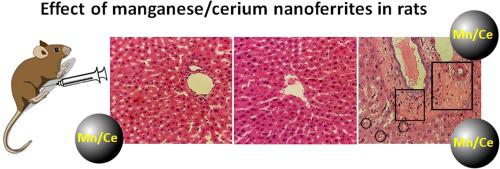Inorganic Chemistry Communications ( IF 3.8 ) Pub Date : 2021-01-05 , DOI: 10.1016/j.inoche.2020.108433 Parisa Hasanein , Abbas Rahdar , Sedigheh Esmaeilzadeh Bahabadi , Arun Kumar , George Z. Kyzas

|
The field of nanoparticles (NPs) is rapidly expanding. Therefore, the potential toxic effect of these materials needs to be investigated. In the current effort, the Mn/Ce magnetite nanoferrites was synthesized via sol-gel method and then characterized to study their structural, morphological, and magnetic properties by XRD, SEM and VSM techniques. Furthermore, we investigated the toxic effects of intraperitoneal administration of Ce-Mn ferrite NPs in male Wistar rats. Two groups of animals received NPs (500 mg/kg, i.p.) daily for 14 and 28 days. For the animals received NPs (1000 mg/kg, i.p.), one group treated for 14 days and another group had similar treatment but subsequently untreated for a period of 14 days before sample collecting. At the end, rats were used for biochemical, haematological and histopathological examinations. Administration of NPs (500 mg/kg) for 14 and 28 days in rats did not induce any change in hepatorenal and hematological parameters. However, rats treated with 1000 mg/kg for 14 days showed hepatotoxicity as revealed by increasing liver enzymes ALT, AST and LDH which led to hepatic oxidative stress indicated by enhanced level of malondialdehyde and diminished contents of hepatic reduced glutathione (GSH), superoxide dismutase (SOD) and catalase (CAT). Rats treated with 1000 mg/kg for 14 days showed fibrosis and hemorrhage in liver parenchyma. All these abnormal changes were alleviated by discontinuation of treatment for 14 days later. Our findings showed that administration of Ce-Mn ferrite NPs (1000 mg/kg, i.p.) for 14 days induces oxidant/antioxidant imbalance and hepatic damage in rats which could be returned to normal conditions two weeks after discontinuation of treatment.
中文翻译:

锰/铈纳米铁氧体对大鼠的影响
纳米颗粒(NPs)的领域正在迅速扩大。因此,需要研究这些材料的潜在毒性作用。在目前的研究中,通过溶胶-凝胶法合成了Mn / Ce磁铁矿纳米铁氧体,然后通过XRD,SEM和VSM技术对其结构,形态和磁性能进行了表征。此外,我们调查了腹腔注射Ce-Mn铁氧体NP对雄性Wistar大鼠的毒性作用。两组动物接受NPs(500 mg / kg,ip),每天持续14天和28天。对于接受NPs(1000 mg / kg,ip)的动物,一组进行了14天的治疗,另一组进行了类似的处理,但随后在样品收集之前未经处理14天。最后,将大鼠用于生化,血液学和组织病理学检查。在大鼠中施用NPs(500 mg / kg)14天和28天不会引起肝肾和血液学参数的任何变化。然而,以1000 mg / kg的剂量治疗14天的大鼠表现出肝毒性,这是由肝脏酶ALT,AST和LDH的增加所揭示的,该酶导致丙二醛水平升高和肝脏还原型谷胱甘肽(GSH)含量,超氧化物歧化酶含量降低,从而指示肝脏氧化应激(SOD)和过氧化氢酶(CAT)。用1000 mg / kg治疗14天的大鼠肝实质出现纤维化和出血。通过停止治疗14天,缓解了所有这些异常变化。我们的研究结果表明,使用Ce-Mn铁氧体NP(1000 mg / kgip)持续14天会在大鼠中诱发氧化剂/抗氧化剂失衡和肝损伤,在停药两周后可恢复至正常状态。


























 京公网安备 11010802027423号
京公网安备 11010802027423号